The Flea Lifecycle - A Simplified Description.
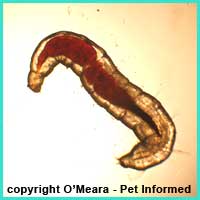 Flea infestation is one of the great banes in life for many pet and poultry owners.
Flea infestation is one of the great banes in life for many pet and poultry owners.
These rather-common insect parasites pose a variety of problems for pets and pet owners including:
- flea bites - adult fleas bite pets and humans, causing pain, redness and itching of the bite site;
- flea allergy dermatitis - pets who are severely allergic to flea saliva can become so itchy (pruritic) as a result of flea bites that they literally tear their skin and fur apart with their scratching and chewing activities;
- coat damage - breeding and showing pets (e.g. poultry, cats) can be penalised in the show ring if their fur (or plumage) is damaged by scratching and over-grooming activities or if it bears the evidence (fleas, flea dirt) of flea parasite infestation;
- skin disease - flea infested skin that is traumatized by flea bites and by animal scratching and biting activities can become secondarily infected with nasty, itchy, skin bacteria;
- anemia - heavy flea infestations can suck so much blood from their animal host that the host can weaken and even die from severe blood loss (anaemia);
- infectious disease transmission - many infectious diseases including: feline infectious anemia (FIA or Mycoplasma hemofelis), bubonic plague (Yersinia pestis), flea tapeworms (Dipylidium caninum), Dipetalonema reconditum, feline parvovirus, murine typhus (Rickettsia typhi), Rickettsia felis, rabbit myxomatosis and certain avian (bird) blood diseases can be transmitted from animal to animal by flea parasites.
- annoyance - most owners don't like to see or hear their pets scratching, particularly at night when the repetitive 'chink, chink, chink' of a collar or chain keeps them awake;
- gross-out factor - the sight of insects crawling through a pet's fur is revolting and off-putting to many people who see such infestations as a sign of 'dirtiness' (even though perfectly clean pets can and do get fleas of course);
- zoonosis - fleas from pets can infest humans, inflicting painful bites and causing itchiness of the skin and scalp.
In order for pet owners and commercial animal producers to fully grasp how it is that flea infestations can become so large and so persistent, it is important for them
to understand the flea lifecycle. In particular, animal owners need to know how and where the
flea parasite reproduces and also where the ample juvenile forms (egg, larva, pupa) of the parasite's lifecycle hide out and evade treatment. The flea life cycle is very important to know if a flea infestation
is to be controlled adequately and permanently (after all, much of the flea life cycle occurs in the animal's environment, not on the animal itself, and so environmental flea control is very important). Knowing the flea lifecycle can provide important clues as to why a particular flea control regime is not working and an explanation as to why the fleas keep on coming back. The flea lifecycle forms the basis of it all for it is the complete cycle of a flea's existence: from egg to larval stage (three larval stages) to pupa to adult stage, to egg stage again with the next generation.
This flea life cycle page contains a detailed, but simple-to-understand explanation of the
complete flea life cycle. It comes complete with a full flea lifecycle diagram for ease of understanding. Pictures of flea eggs, flea larvae and adult fleas are also included.

IMPORTANT AUTHOR'S NOTE:
You'll notice that this page is very similar in appearance to another flea lifecycle page that
already appears on our site. This is deliberate. This particular page is intended for those
of you who only want bare-basics, simplified information about the flea lifecycle itself (i.e. without
added information on flea control).
The other page on our site is more detailed and contains extensive information
on how the flea lifecycle can be used to guide effective flea control and flea prevention in the home
and outdoors. It discusses every stage in the flea lifecycle (as this page does) and then gives information about how each stage of the flea lifecycle can be broken through the use of chemical and non-chemical means. I have included that detailed page because flea control and prevention is
such a huge issue in many households (once fleas are established, many people find them very difficult to
get rid of - often because most people don't realise just how many stages of the parasite exist off the pet
and in the environment) and because such flea eradication can only be achieved by a complete understanding of the flea life cycle itself.
To go to our more detailed flea life cycle and flea control page, click here.

The Flea Life Cycle: A Simplified Description - Contents:
1) The flea life cycle diagram - a complete step-by-step diagram of animal host flea infestation; flea reproduction and environmental flea contamination with juvenile flea life cycle stages (eggs, larvae and pupae).
2) Photographic pictures of the various flea lifecycle stages.
3) Simple descriptions of each of the stages of the flea life cycle.

1) The Flea Life Cycle Diagram:
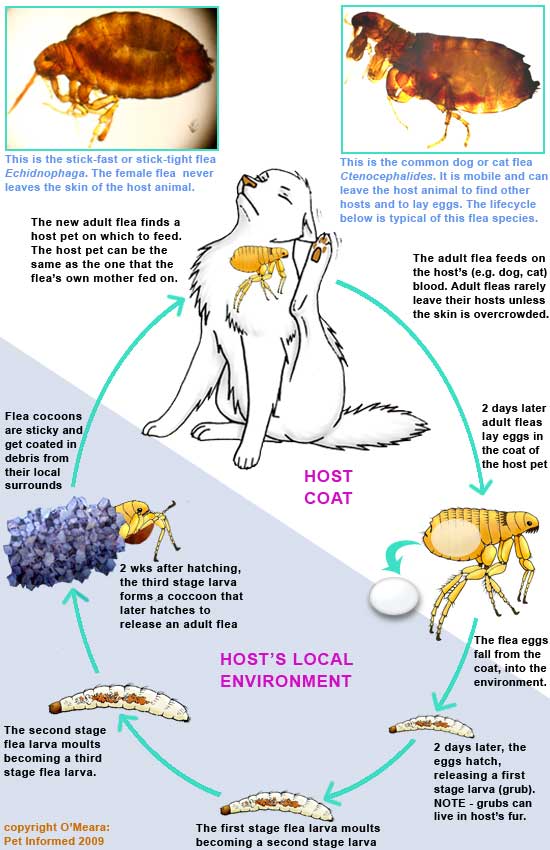
Flea life cycle diagram: This is a diagram of the flea lifecycle as it applies to the majority of flea species types.
The flea lifecycle diagram is divided into two sections: a white section and a grey section, which represent respectively the stages of the flea life cycle that occur on the host animal's skin (in this case: the dog's skin) and in the host animal's environment (in this case: the carpet of the house, the dog's bedding, the dog's kennel and so on).
The timing of the various flea lifecycle stages:
- Egg - The flea egg hatches in 2-21 days, depending on environmental conditions.
- Three larval stages - The larval stages grow and undergo their moults over about 9-15 days.
- The pupal stage (cocoon) - The cocoon is the crux of flea infestation persistence in the house-hold. It generally hatches in 1-2 weeks, but can last up to a year.
- The adult flea - Adult fleas can live for some weeks (maximum of about 2 months if no host is present) in ideal, cool, moist conditions.
This particular diagram illustrates the life cycle of the dog or cat flea (
Ctenocephalides canis and
C. felis), however, the diagram would also be appropriate to a vast range of other flea types, including:
Echidnophaga gallinacea (the poultry "sticktight" flea - discussed in the paragraph below); the rabbit
fleas -
Cediopsylla simplex and
Spilopsyllus cuniculi; the rat flea (
Xenopsylla cheopis); the human flea (
Pulex irritans) and various other flea species. The main difference between these other flea life cycle situations and that of
Ctenocephalides (pictured) would be the host animal species infested by the flea (e.g. the rabbit host instead of the dog for
Cediopsylla simplex and
Spilopsyllus cuniculi) and the nature of the
environment in which the flea larvae and pupal stages underwent development (e.g. the dirt rabbit burrow
instead of the household carpet in the case of
Cediopsylla simplex and
Spilopsyllus cuniculi).
Author's note - In the case of
Echidnophaga gallinacea, the poultry stickfast or sticktight
flea, the male and female fleas mate in the flea's environment (soon after hatching from their pupal cocoons), not on the host itself as occurs with many other flea species. After mating has occurred, the female flea attaches herself strongly to the skin of a passing animal host and remains in that one place for about 6 weeks, feeding and laying eggs. She does not move from the spot she has chosen. The eggs she produces drop from the animal host's skin and into the soil environment where they undergo hatching, a 2-4 week larval development period and pupation.
Echidnophaga pupation occurs in a burrow underground and hatching of the adult flea
occurs in around 2-3 weeks. The total
Echidnophaga flea lifecycle is about 4-6 weeks long.
 2) Pictures Of The Various Flea Lifecycle Stages:
FLEA EGGS
2) Pictures Of The Various Flea Lifecycle Stages:
FLEA EGGS
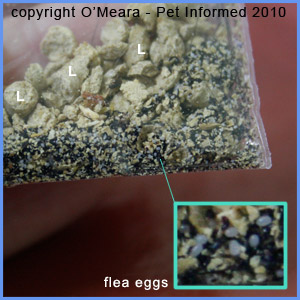 Flea lifecycle - Flea eggs picture:
Flea lifecycle - Flea eggs picture: It is normally very difficult to spot flea eggs in the typical household
environment - even though there may be many thousands of them present in a household environment, they are pale in color (hard to see), tiny and they tend to fall deep into clefts in lawns and carpeting. For this reason it is not unexpected that most pet owners will never have before seen
a flea egg up close.
This particular image came as a result of my working in a vet clinic. We had a cat with a severe flea burden in one of our metal hospital cages. When the animal had finished with the cage, a thick film of black flea dirt, fur and kitty litter (the tan 'rocks' marked with an 'L'
in the image above) had remained behind on the smooth metal floor. I swept these up and put them
in a clear sandwich bag (image). After some vigorous shaking, the flea dirt (black) and the flea eggs (shiny, white-grey
ovals) settled out in the bottom of the bag and were easy to see and photograph.
The flea eggs are the white-grey (pearly-colored) ovals seen in the lower reaches of the bag (I have included
a close-up picture of them - see box inset). They are about 0.5mm long. You can appreciate how small
the eggs are by comparing them to the size of the kitty litter gravel (marked as 'L' in the image).
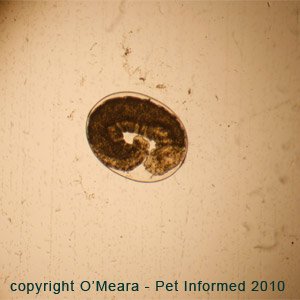
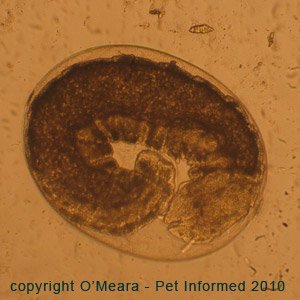 Flea lifecycle - Flea egg photos:
Flea lifecycle - Flea egg photos: These are images of one of the flea eggs pictured above, taken through
the microscope. The flea egg is ovoid, with a thin shell. A flea larvae lays curled up inside, ready to
hatch in the near future. I think this flea larva may have been very close to hatching because
it was jiggling around inside the egg while the image was being taken.
FLEA LARVAE
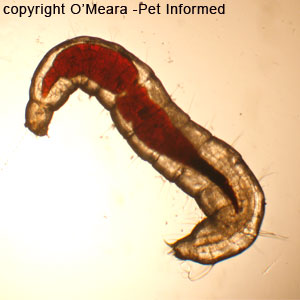 Flea lifecycle - Flea larva picture:
Flea lifecycle - Flea larva picture: This is an image of a flea larva as it appears through the microscope. The flea larva's head is to the left of this image.
When it is spotted in the household environment or observed crawling about on a pet's coat, a flea larva looks very much like a small, white caterpillar or maggot with a dark, anteriorly-to-centrally-located core region (stomach). Under the microscope, the juvenile flea grub is almost transparent (see image above). The large, red organ (anteriorly-to-centrally-located core region) that you can see in this flea larvae is its stomach. The larval stomach appears red because the flea larva has been feeding on the black droppings of adult fleas (flea dirt): its usual diet. This 'flea dirt' is comprised of digested blood and appears red (it is not truly black) when liquefied in the belly of the larval flea.
FLEA COCOON or FLEA PUPA
Sorry, I can't help you just yet with my own picture of one of these. Flea cocoons are really hard to find
in the vet clinic because vet clinics rarely get to establish an endemic environmental flea population (I'd be a bit worried
if a vet clinic found it hard to get rid of fleas!). If I do get some pupa images of my own, I'll put them up for you.
I have, instead, found a link to some very nice pictures of flea cocoons (flea pupae) and other flea life cycle stages, which show you what they look like. The last three images on the page show the pupae: both as they appear in nature (the first pupal picture which looks like a series of grit-covered balls) and as they appear when the naked, white pupa has been dissected out of the cocoon. Enjoy.
http://www.icb.usp.br/~marcelcp/Ctenocephalidesfelis.htm
FLEA ADULT
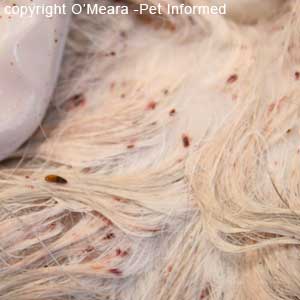 Flea lifecycle picture:
Flea lifecycle picture: This is an image of an adult
Ctenocephalides flea as it appears
in the fur of a cat. The flea is located to the left of the image. The red specks seen throughout
the fur are smudges of flea dirt that have become wet and therefore leached red blood-pigments out into the surrounding hair. Light-coloured cats with severe flea dirt will turn
a red-pink colour when washed because of the blood-products leaking out of the flea dirt and into the surrounding hair.
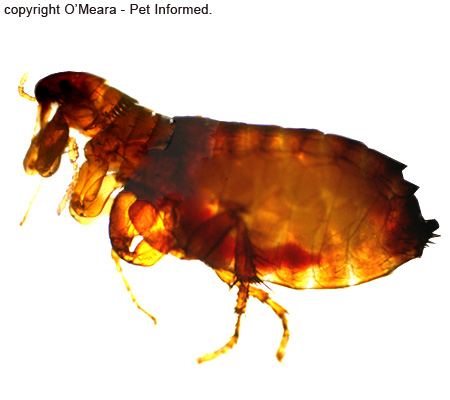 Flea lifecycle adult flea image:
Flea lifecycle adult flea image: This is an image of an adult
Ctenocephalides flea as it appears
under the microscope.
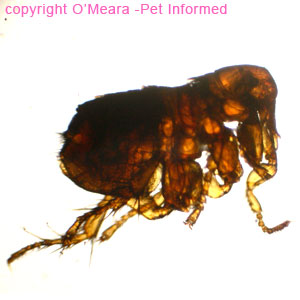 Flea lifecycle adult flea image:
Flea lifecycle adult flea image: This is an image of an adult rabbit flea as it appears
under the microscope. Rabbit fleas like
Cediopsylla simplex and
Spilopsyllus cuniculi
are stickfast-type fleas with long penetrating mouth parts (see the huge mouth parts of the stickfast poultry flea
below for a better illustration of this) for holding tightly onto the skin of
their swift-moving hosts. Although their main host is the rabbit, they are sometimes found on the ears and faces of cats who go into rabbit holes to hunt bunnies. This particular flea was
picked from the ear of just such a cat.
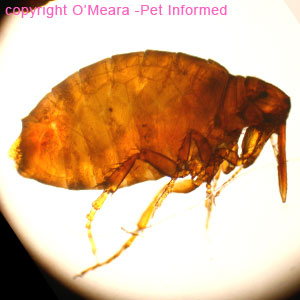 Flea lifecycle adult flea image:
Flea lifecycle adult flea image: This is an image of an adult stickfast flea (
Echidnophaga) as it appears
under the microscope. It has a smallish head and massive, penetrating mouth parts for holding onto its host's skin. Although this flea is normally considered to be a poultry flea, it gets onto a range of other host species, including dogs and cats. This particular flea was one of hundreds that we picked off an echidna.
 3) Simple Descriptions Of Each Of The Stages Of The Flea Lifecycle.
3) Simple Descriptions Of Each Of The Stages Of The Flea Lifecycle.
The following subsections of this flea lifecycle page contain detailed, but simple-to-understand information about each of the steps outlined in
the flea lifecycle diagram (seen in section 1). The following discussion of each of the individual steps in the flea lifecycle aims to add more to your understanding of host flea
infestation; flea reproduction and how severe environmental flea contamination builds-up and subsequent host animal re-infestation occurs.
Flea Life Cycle 1 - The adult flea lays her eggs on the host animal:
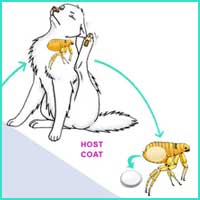 In the case of Ctenocephalides (the dog or cat flea), both the male and female adult fleas are present on the host animal's skin, living, feeding and breeding there.
Of the two sexes, however, it is the female flea that is the bigger blood-sucker, drinking far
more of the host's blood than any of the male fleas that climb on board. Conversely, in certain other flea
life cycles (e.g. Echidnophaga), the adult male flea remains in the host's environment and only the adult female flea actually inhabits the furcoat of the host animal. Either way, the most important thing to remember is that it is the female flea who is the major animal host
parasite and the predominant blood-sucker of the two flea sexes.
In the case of Ctenocephalides (the dog or cat flea), both the male and female adult fleas are present on the host animal's skin, living, feeding and breeding there.
Of the two sexes, however, it is the female flea that is the bigger blood-sucker, drinking far
more of the host's blood than any of the male fleas that climb on board. Conversely, in certain other flea
life cycles (e.g. Echidnophaga), the adult male flea remains in the host's environment and only the adult female flea actually inhabits the furcoat of the host animal. Either way, the most important thing to remember is that it is the female flea who is the major animal host
parasite and the predominant blood-sucker of the two flea sexes.
The main reason why the female flea needs to parasitize the host animal is because, after breeding with the male flea, she needs a blood meal in order for her eggs to develop fully. Without a host, adult female fleas will starve and be unable to produce any viable eggs.
The adult flea lays her eggs on the host's skin. She does not bother getting off the host to lay them. The flea eggs are shiny, white, ovoid eggs, about 0.5mm in length.
Flea Life Cycle 2 - The egg falls off the fur into the environment of the host animal:
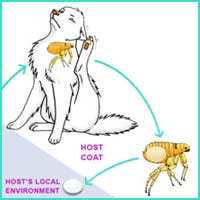 The white flea eggs are laid on the host animal's skin, however, they usually fall off the host
animal's coat and into the host animal's environment prior to hatching. These flea eggs (and the flea larvae
that subsequently hatch out of them) contaminate the host animal's environment. As expected, environmental flea egg numbers and environmental flea infestations are generally most concentrated in regions of the household where the flea-infested pet spends most of its time.
Common sites of egg and flea concentration include: pet beds and pet bedding; owner beds (if the pet sleeps on the human beds); carpet (carpet fleas or house flea infestations are a huge nuisance because they can be difficult to get rid of); pet houses or kennels; human couches and outdoor settings
(if the pet has access to these furnishings) and various cool, moist, humid, shaded outdoor regions of the yard that the pet spends lots of time in (e.g. thick garden beds, sheds, dens under the house or verandah and so on).
The white flea eggs are laid on the host animal's skin, however, they usually fall off the host
animal's coat and into the host animal's environment prior to hatching. These flea eggs (and the flea larvae
that subsequently hatch out of them) contaminate the host animal's environment. As expected, environmental flea egg numbers and environmental flea infestations are generally most concentrated in regions of the household where the flea-infested pet spends most of its time.
Common sites of egg and flea concentration include: pet beds and pet bedding; owner beds (if the pet sleeps on the human beds); carpet (carpet fleas or house flea infestations are a huge nuisance because they can be difficult to get rid of); pet houses or kennels; human couches and outdoor settings
(if the pet has access to these furnishings) and various cool, moist, humid, shaded outdoor regions of the yard that the pet spends lots of time in (e.g. thick garden beds, sheds, dens under the house or verandah and so on).
Author's note: Because cats will tend to patrol and take-over an entire house, including amazingly elevated places (e.g. the tops of wardrobes and cupboards) and hidden, often-enclosed places (e.g. the inside of pantries, walk-in-robes, linen closets and so on), every room and part of a house
that an indoors, flea-affected cat has access to should be considered contaminated with flea eggs.
This can make flea control in a house with flea infested cats very difficult and expensive to manage.
Author's note: Because it only takes about 2 days for flea eggs to hatch once they have been laid, some flea eggs will manage to avoid falling into the pet's environment and will hatch on the pet's coat. It is not that uncommon to have hatched flea larvae (small flea maggots or grubs) turn up on the animal's coat. These flea larvae will usually drop off the host animal's coat soon after hatching and enter the host's environment to continue the "off-host" part of the fleas lifecycle.
Author's note: It is VERY important to consider the environment of the host
when attempting to eradicate and eliminate fleas from a host animal. A huge part of the flea lifecycle
occurs off the host animal. If an animal has adult fleas on its coat, then the pet's environment has many more eggs, larvae and pupal fleas just waiting to develop into adults and hop on board. You must treat
the host and the host's environment to get rid of fleas.
Flea Life Cycle 3 - The flea egg hatches, releasing a first stage (stage 1) flea larva.
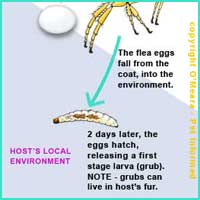 After about 2 days (range 2-21 days), depending on environmental conditions, the flea egg hatches to
release a first stage flea larva. This flea larva lives in the host's environment
(it is part of the environmental stage of the fleas life cycle), where it feeds on flea
droppings (flea dirt) and dander.
After about 2 days (range 2-21 days), depending on environmental conditions, the flea egg hatches to
release a first stage flea larva. This flea larva lives in the host's environment
(it is part of the environmental stage of the fleas life cycle), where it feeds on flea
droppings (flea dirt) and dander.
Author's note: Because it only takes about 2 days for flea eggs to hatch once they have been laid, some flea eggs will manage to avoid falling into the pet's environment and will hatch on the pet's coat. It is not that uncommon to have hatched flea larvae (small flea maggots or grubs) turn up on the animal's coat. These flea larvae will usually drop off the host animal's coat soon after hatching and enter the host's environment to continue the "off-host" part of the flea lifecycle.
Author's note: It is VERY important to consider the environment of the host
when attempting to eradicate and eliminate fleas from a host animal. A huge part of the flea life cycle
occurs off the host animal. If an animal has adult fleas on its coat, then the pet's environment has many more eggs, larvae and pupal fleas just waiting to develop into adults and hop on board. You must treat
the host and the host's environment to get rid of fleas.
Flea Life Cycle 4 - The first stage flea larvae develop and grow and undergo two molts to become final stage flea larvae.
 Over about 9-15 days, depending on environmental conditions, the first stage flea larva grows and develops
and undergoes a series of molts (two moults) to become a third stage (final stage) flea larva.
This final stage flea larva is the stage that will spin a cocoon around itself in readiness to become an adult flea. The three larval flea stages live freely in the host's environment
(they are part of the environmental stage of the flea life cycle), where they feed on flea
droppings (flea dirt) and dander.
Over about 9-15 days, depending on environmental conditions, the first stage flea larva grows and develops
and undergoes a series of molts (two moults) to become a third stage (final stage) flea larva.
This final stage flea larva is the stage that will spin a cocoon around itself in readiness to become an adult flea. The three larval flea stages live freely in the host's environment
(they are part of the environmental stage of the flea life cycle), where they feed on flea
droppings (flea dirt) and dander.
Author's note: It is VERY important to consider the environment of the host
when attempting to eradicate and eliminate fleas from a host animal. A huge part of the flea life cycle
occurs off the host animal. If an animal has adult fleas on its coat, then the pet's environment has many more eggs, larvae and pupal fleas just waiting to develop into adults and hop on board. You must treat
the host and the host's environment to get rid of fleas.
Flea Life Cycle 5 - The final stage flea larva spins a cocoon and becomes a pupa:
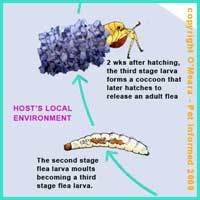 The final stage flea larva spins a cocoon around itself, becoming what is termed a pupa.
Just like a butterfly caterpillar spins a cocoon around itself in order to metamorphose
into a butterfly, so too does the flea larva need to spin a cocoon in order to change into an
adult flea. The cocoon of the flea pupa is very sticky and tends to become covered in dirt, dander
and debris from the surrounding environment, thus making it almost unrecognizable to pet owners.
The final stage flea larva spins a cocoon around itself, becoming what is termed a pupa.
Just like a butterfly caterpillar spins a cocoon around itself in order to metamorphose
into a butterfly, so too does the flea larva need to spin a cocoon in order to change into an
adult flea. The cocoon of the flea pupa is very sticky and tends to become covered in dirt, dander
and debris from the surrounding environment, thus making it almost unrecognizable to pet owners.
The flea cocoon or pupa is the most long-lived stage of the flea lifecycle - taking anywhere up to a year or more to hatch. The pupa is the life cycle stage of the flea that is the most vital
to a flea population's persistence in a host environment. The reason why this stage of the flea life cycle
is so important to the flea population as a whole is because of the fact that flea cocoons generally only hatch in the presence of a host animal. They hatch in response to the host animal's warmth, movement (the host animal produces vibrations, as it walks over the carpet and flooring,
which trigger the fleas to hatch out) and breathed-out CO2.
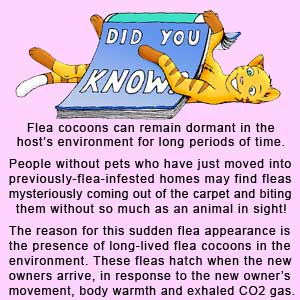 Flea pupae do not generally hatch out spontaneously, in response to a certain time limit or a change in
season. Instead, they wait until a host animal is available for feeding on and for all of the requirements of
the flea life cycle to be present (they are very clever) before they hatch. For this reason, simply depopulating
a previously-flea-infested environment and leaving it free of hosts for a specified period of time
is no guarantee of fleas not hatching back to life when the host animals finally return (unless you are willing
to leave the environment depopulated for well over a year). The fleas will simply lie dormant in
their cocoons and wait - they can wait for many many months for a host to reappear. They are
patient. Cocoon eradication is, thus, very important if an environment is to be rendered completely free of fleas.
Flea pupae do not generally hatch out spontaneously, in response to a certain time limit or a change in
season. Instead, they wait until a host animal is available for feeding on and for all of the requirements of
the flea life cycle to be present (they are very clever) before they hatch. For this reason, simply depopulating
a previously-flea-infested environment and leaving it free of hosts for a specified period of time
is no guarantee of fleas not hatching back to life when the host animals finally return (unless you are willing
to leave the environment depopulated for well over a year). The fleas will simply lie dormant in
their cocoons and wait - they can wait for many many months for a host to reappear. They are
patient. Cocoon eradication is, thus, very important if an environment is to be rendered completely free of fleas.
Author's note: It is VERY important to consider the environment of the host
when attempting to eradicate and eliminate fleas from a host animal. A huge part of the flea life cycle
occurs off the host animal. If an animal has adult fleas on its coat, then the pet's environment has many more eggs, larvae and pupal fleas just waiting to develop into adults and hop on board. You must treat
the host and the host's environment to get rid of fleas.
Flea Life Cycle 6 - The cocoon hatches and an adult flea comes out, looking for mates and a host animal to feed on:
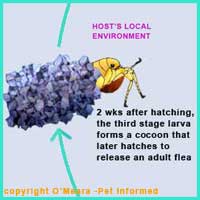 The pupa contained inside of the flea cocoon hatches out in the presence of a host animal and an adult
flea appears. Just like a butterfly caterpillar spins a cocoon around itself in order to metamorphose
into an adult butterfly, so too does the flea larva need to spin a cocoon around itself in order to change into an
adult flea. The cocoon of the flea pupa is very sticky and tends to become covered in dirt, dander
and debris from the surrounding environment, making it almost impossible for pet owners to recognize.
The pupa contained inside of the flea cocoon hatches out in the presence of a host animal and an adult
flea appears. Just like a butterfly caterpillar spins a cocoon around itself in order to metamorphose
into an adult butterfly, so too does the flea larva need to spin a cocoon around itself in order to change into an
adult flea. The cocoon of the flea pupa is very sticky and tends to become covered in dirt, dander
and debris from the surrounding environment, making it almost impossible for pet owners to recognize.
The flea cocoon or pupa is the most long-lived stage of the flea lifecycle - taking anywhere up to a year or more to hatch. The pupa is the life cycle stage of the flea that is the most vital
to a flea population's persistence in a host environment. The reason why this stage of the flea life cycle
is so important to the flea population as a whole is because of the fact that flea cocoons generally only hatch in the presence of a host animal. They hatch in response to the host animal's warmth, movement (the host animal produces vibrations, as it walks over the carpet and flooring,
which trigger the fleas to hatch out) and breathed-out CO2.
Flea pupae do not generally hatch out spontaneously, in response to a certain time limit or a change in
season. Instead, they wait until a host animal is available for feeding on and for all of the requirements of
the flea lifecycle to be present (they are very clever) before they hatch. For this reason, simply depopulating
a previously-flea-infested environment and leaving it free of hosts for a specified period of time
is no guarantee of fleas not hatching back to life when the host animals finally return (unless you are willing
to leave the environment depopulated for well over a year). The fleas will simply lie dormant in
their cocoons and wait - they can wait for many many months for a host to reappear. They are
patient. Cocoon eradication is, thus, very important if an environment is to be rendered completely free of fleas.
Author's note: It is VERY important to consider the environment of the host
when attempting to eradicate and eliminate fleas from a host animal. A huge part of the flea lifecycle
occurs off the host animal. If an animal has adult fleas on its coat, then the pet's environment has many more eggs, larvae and pupal fleas just waiting to develop into adults and hop on board. You must treat
the host and the host's environment to get rid of fleas.
Flea Life Cycle 7 - The adult male and female fleas jump onto the host animal to feed, mate and lay eggs:
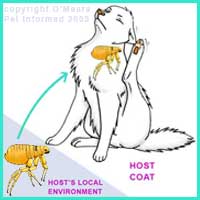 The newly-hatched adult fleas seek out the host animal and jump aboard, starting the flea lifecycle all over again.
The newly-hatched adult fleas seek out the host animal and jump aboard, starting the flea lifecycle all over again.
In the case of Ctenocephalides (the dog or cat flea), both the male and female adult fleas will migrate onto the host animal's skin and live, feed and breed there.
Of the two sexes, however, it is the female flea that is the bigger blood-sucker, drinking far
more of the host's blood than any of the male fleas that climb on board. Conversely, in certain other flea
life cycles (e.g. Echidnophaga), the adult male flea remains in the host's environment and only the adult female flea actually inhabits the furcoat of the host animal. Either way, the most important thing to remember is that it is the female flea who is the major animal host
parasite and the predominant blood-sucker of the two flea sexes.
The main reason why the female flea needs to parasitise the host animal is because, after breeding with the male flea, she needs a blood meal in order for her eggs to develop fully. Without a host, adult female fleas will starve and be unable to produce any viable eggs.
It is important to remember that the household is not the only place where domestic pets can pick up adult fleas. Any place where lots of dogs and cats and other flea hosts spend time can develop a flea problem. All it takes is for flea infested pets to drop eggs into the environment and for enough unprotected hosts to come and go to keep the infection and flea transmission rates high.
Consequently, dog parks, boarding kennels, catteries, shelters, pounds, breeding facilities, grooming salons, vet clinics, show ground facilities and pet 'day care' centres should all be considered high risk for contracting adult fleas,
particularly if a pet host has not been sufficiently flea protected (i.e. with adulticide flea preventatives).
Fleas can also build up to significant levels in places where there are enough infested wild and stray/feral animal hosts to keep the flea life cycle going. Rabbit burrows, wolf and coyote dens, feral/stray cat haunts and feral/wild dog dens can build up a large adult flea
population that is just waiting for your cat or dog to happen by and catch them. Additionally,
flea infested wild and feral animals can take up residence in a pet owner's yard (e.g. in sheds, wood-piles, under the house, under the verandah), resulting in a significant flea build-up in the regions they inhabit. These flea parasites can then infest domestic pets, particularly if these pets venture into the nesting sites where the wild
or stray animal resides (e.g. the pet goes under the house).

4) Your flea lifecycle links:
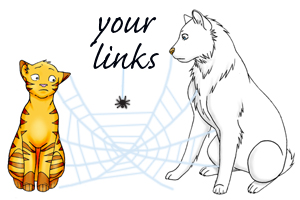
To go from this fleas life cycle page to the Pet Informed Home Page, click here.
To go from this flea life cycle page to the Flea Pictures page, click here.
To go from this basic flea lifecycle page to our more detailed page on "breaking the flea life cycle to achieve full flea control," click here.

Flea Lifecycle - References and Suggested Readings:
1) Arthropods. In Bowman DD, Lynn RC, Eberhard ML editors: Parasitology for Veterinarians, USA, 2003, Elsevier Science.
2) Phylum Arthropoda. In Hobbs RP, Thompson ARC, Lymbery AJ: Parasitology, Perth, 1999, Murdoch University.
3) External Infestations - Small Animals. In Wroth O, editor: MIMS IVS Annual. St Leonards, 2001, Havas MediMedia.
4) Miscellaneous. In Wroth O, editor: MIMS IVS Annual. St Leonards, 2001, Havas MediMedia.
5) Crapp B, Stickfast Fleas. Queensland Primary Industries and Fisheries. http://www.dpi.qld.gov.au/cps/rde/dpi/hs.xsl/27_2744_ENA_HTML.htm
6) Parasitic Skin Disease. In Muller GH, et al.: Muller and Kirk's Small Animal Dermatology, 6th ed. USA, 2001, Elsevier Health Sciences.

Pet Informed is not in any way affiliated with any of the companies whose products
appear in images or information contained within this flea lifecycle article or our related articles. Any images, taken by Pet Informed, are only used in order to illustrate certain points being made in the flea lifecycle article. Pet Informed receives no commercial or reputational benefit from any companies
for mentioning their products and can not make any guarantees or claims, either positive or negative, about these companies' products, customer service or business practices. Pet Informed can not and will not take any responsibility for any death, damage, illness, injury or loss of reputation and business
or for any environmental damage that occurs should you choose to use one of the mentioned products on your pets, poultry or livestock (commercial or otherwise) or indoors or outdoors environments. Do your homework and research all flea products carefully before using any flea products on your animals
or their environments.
Copyright April 15, 2010, Dr. O'Meara, www.pet-informed-veterinary-advice-online.com.
All images, both photographic and drawn, contained on this flea lifecycle page are the property of Dr. O'Meara and are protected under copyright. They can not be used without my written permission.
Please note: the aforementioned flea prevention, flea control and flea treatment
guidelines and information on the flea lifecycle are general information and recommendations only. The information provided is based on published information and on recommendations made available from the drug companies themselves; relevant veterinary literature
and publications and my own experience as a practicing veterinarian.
The flea lifecycle advice given is appropriate to the vast majority of pet owners, however, given
the large range of flea medication types and flea prevention and control protocols now available, owners should take it upon themselves to ask their own veterinarian what treatment and flea prevention schedules s/he is using so as
to be certain what to do. Owners with specific circumstances (high flea infestation
burdens in their pet's environment, pregnant bitches and queens, very young puppies and kittens,
flea infested ferrets, flea infested rabbits, dog, cat and rabbit breeders, livestock and poultry
producers, multiple-dog and cat environments, animals with severe flea allergy dermatitis, animals on immune-suppressant medicines, animals with immunosuppressant diseases or conditions, owners of sick and
debilitated animals etc. etc.) should ask their vet what the safest and most effective flea protocol is for their situation.
Please note: the scientific flea names mentioned in this flea lifecycle article are only current as
of the date of this web-page's copyright date. Parasite scientific names are constantly being
reviewed and changed as new scientific information becomes available and names that are current
now may alter in the future.








 Flea infestation is one of the great banes in life for many pet and poultry owners.
Flea infestation is one of the great banes in life for many pet and poultry owners. 
 In the case of Ctenocephalides (the dog or cat flea), both the male and female adult fleas are present on the host animal's skin, living, feeding and breeding there.
Of the two sexes, however, it is the female flea that is the bigger blood-sucker, drinking far
more of the host's blood than any of the male fleas that climb on board. Conversely, in certain other flea
life cycles (e.g. Echidnophaga), the adult male flea remains in the host's environment and only the adult female flea actually inhabits the furcoat of the host animal. Either way, the most important thing to remember is that it is the female flea who is the major animal host
parasite and the predominant blood-sucker of the two flea sexes.
In the case of Ctenocephalides (the dog or cat flea), both the male and female adult fleas are present on the host animal's skin, living, feeding and breeding there.
Of the two sexes, however, it is the female flea that is the bigger blood-sucker, drinking far
more of the host's blood than any of the male fleas that climb on board. Conversely, in certain other flea
life cycles (e.g. Echidnophaga), the adult male flea remains in the host's environment and only the adult female flea actually inhabits the furcoat of the host animal. Either way, the most important thing to remember is that it is the female flea who is the major animal host
parasite and the predominant blood-sucker of the two flea sexes.  The white flea eggs are laid on the host animal's skin, however, they usually fall off the host
animal's coat and into the host animal's environment prior to hatching. These flea eggs (and the flea larvae
that subsequently hatch out of them) contaminate the host animal's environment. As expected, environmental flea egg numbers and environmental flea infestations are generally most concentrated in regions of the household where the flea-infested pet spends most of its time.
Common sites of egg and flea concentration include: pet beds and pet bedding; owner beds (if the pet sleeps on the human beds); carpet (carpet fleas or house flea infestations are a huge nuisance because they can be difficult to get rid of); pet houses or kennels; human couches and outdoor settings
(if the pet has access to these furnishings) and various cool, moist, humid, shaded outdoor regions of the yard that the pet spends lots of time in (e.g. thick garden beds, sheds, dens under the house or verandah and so on).
The white flea eggs are laid on the host animal's skin, however, they usually fall off the host
animal's coat and into the host animal's environment prior to hatching. These flea eggs (and the flea larvae
that subsequently hatch out of them) contaminate the host animal's environment. As expected, environmental flea egg numbers and environmental flea infestations are generally most concentrated in regions of the household where the flea-infested pet spends most of its time.
Common sites of egg and flea concentration include: pet beds and pet bedding; owner beds (if the pet sleeps on the human beds); carpet (carpet fleas or house flea infestations are a huge nuisance because they can be difficult to get rid of); pet houses or kennels; human couches and outdoor settings
(if the pet has access to these furnishings) and various cool, moist, humid, shaded outdoor regions of the yard that the pet spends lots of time in (e.g. thick garden beds, sheds, dens under the house or verandah and so on).
 After about 2 days (range 2-21 days), depending on environmental conditions, the flea egg hatches to
release a first stage flea larva. This flea larva lives in the host's environment
(it is part of the environmental stage of the fleas life cycle), where it feeds on flea
droppings (flea dirt) and dander.
After about 2 days (range 2-21 days), depending on environmental conditions, the flea egg hatches to
release a first stage flea larva. This flea larva lives in the host's environment
(it is part of the environmental stage of the fleas life cycle), where it feeds on flea
droppings (flea dirt) and dander.  Over about 9-15 days, depending on environmental conditions, the first stage flea larva grows and develops
and undergoes a series of molts (two moults) to become a third stage (final stage) flea larva.
This final stage flea larva is the stage that will spin a cocoon around itself in readiness to become an adult flea. The three larval flea stages live freely in the host's environment
(they are part of the environmental stage of the flea life cycle), where they feed on flea
droppings (flea dirt) and dander.
Over about 9-15 days, depending on environmental conditions, the first stage flea larva grows and develops
and undergoes a series of molts (two moults) to become a third stage (final stage) flea larva.
This final stage flea larva is the stage that will spin a cocoon around itself in readiness to become an adult flea. The three larval flea stages live freely in the host's environment
(they are part of the environmental stage of the flea life cycle), where they feed on flea
droppings (flea dirt) and dander.  The final stage flea larva spins a cocoon around itself, becoming what is termed a pupa.
Just like a butterfly caterpillar spins a cocoon around itself in order to metamorphose
into a butterfly, so too does the flea larva need to spin a cocoon in order to change into an
adult flea. The cocoon of the flea pupa is very sticky and tends to become covered in dirt, dander
and debris from the surrounding environment, thus making it almost unrecognizable to pet owners.
The final stage flea larva spins a cocoon around itself, becoming what is termed a pupa.
Just like a butterfly caterpillar spins a cocoon around itself in order to metamorphose
into a butterfly, so too does the flea larva need to spin a cocoon in order to change into an
adult flea. The cocoon of the flea pupa is very sticky and tends to become covered in dirt, dander
and debris from the surrounding environment, thus making it almost unrecognizable to pet owners.
 Flea pupae do not generally hatch out spontaneously, in response to a certain time limit or a change in
season. Instead, they wait until a host animal is available for feeding on and for all of the requirements of
the flea life cycle to be present (they are very clever) before they hatch. For this reason, simply depopulating
a previously-flea-infested environment and leaving it free of hosts for a specified period of time
is no guarantee of fleas not hatching back to life when the host animals finally return (unless you are willing
to leave the environment depopulated for well over a year). The fleas will simply lie dormant in
their cocoons and wait - they can wait for many many months for a host to reappear. They are
patient. Cocoon eradication is, thus, very important if an environment is to be rendered completely free of fleas.
Flea pupae do not generally hatch out spontaneously, in response to a certain time limit or a change in
season. Instead, they wait until a host animal is available for feeding on and for all of the requirements of
the flea life cycle to be present (they are very clever) before they hatch. For this reason, simply depopulating
a previously-flea-infested environment and leaving it free of hosts for a specified period of time
is no guarantee of fleas not hatching back to life when the host animals finally return (unless you are willing
to leave the environment depopulated for well over a year). The fleas will simply lie dormant in
their cocoons and wait - they can wait for many many months for a host to reappear. They are
patient. Cocoon eradication is, thus, very important if an environment is to be rendered completely free of fleas.
 The pupa contained inside of the flea cocoon hatches out in the presence of a host animal and an adult
flea appears. Just like a butterfly caterpillar spins a cocoon around itself in order to metamorphose
into an adult butterfly, so too does the flea larva need to spin a cocoon around itself in order to change into an
adult flea. The cocoon of the flea pupa is very sticky and tends to become covered in dirt, dander
and debris from the surrounding environment, making it almost impossible for pet owners to recognize.
The pupa contained inside of the flea cocoon hatches out in the presence of a host animal and an adult
flea appears. Just like a butterfly caterpillar spins a cocoon around itself in order to metamorphose
into an adult butterfly, so too does the flea larva need to spin a cocoon around itself in order to change into an
adult flea. The cocoon of the flea pupa is very sticky and tends to become covered in dirt, dander
and debris from the surrounding environment, making it almost impossible for pet owners to recognize.
 The newly-hatched adult fleas seek out the host animal and jump aboard, starting the flea lifecycle all over again.
The newly-hatched adult fleas seek out the host animal and jump aboard, starting the flea lifecycle all over again. 